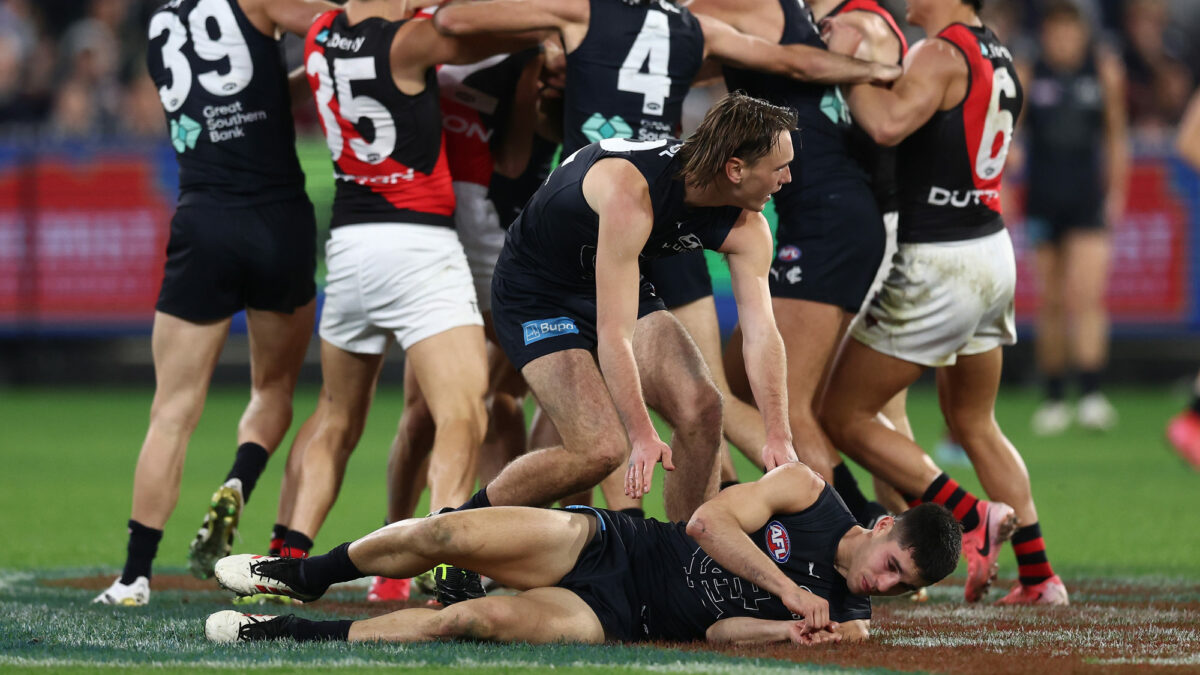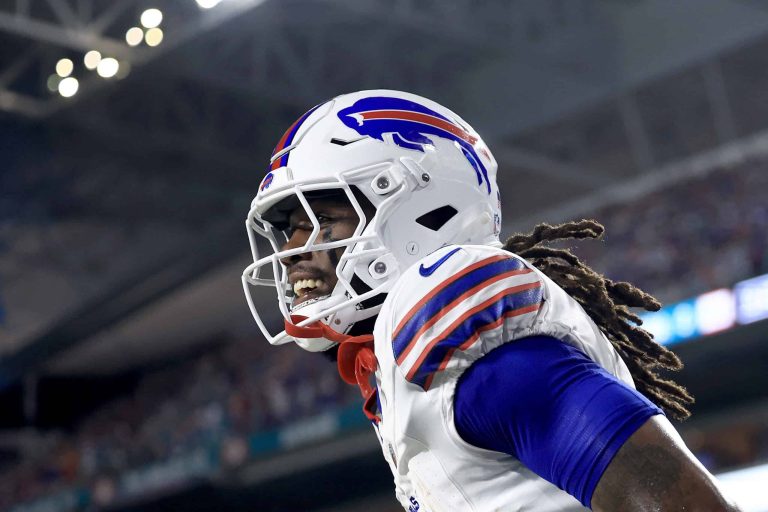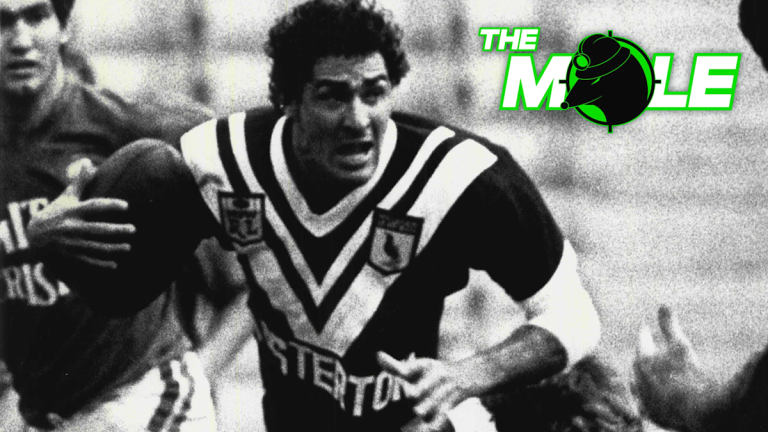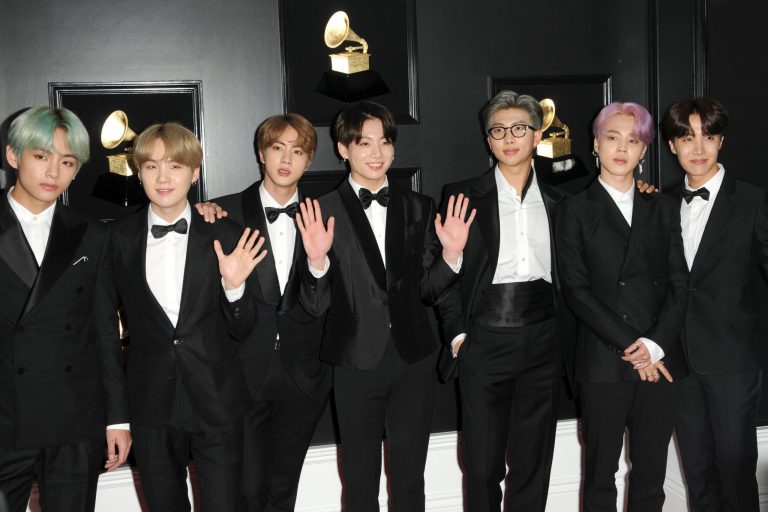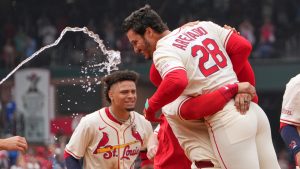Round 13 still has one game to go – and it had better be a good one between Collingwood and Melbourne on King’s Birthday, because the weekend so far has been … rather stinky.
Saturday was the lowest-scoring day of footy in the AFL era, 2020 excluded, probably making Seven feel relieved they don’t have the rights to that day anymore – while Bunbury’s introduction to AFL footy on Sunday saw probably the worst game of the year, though at least North Melbourne’s win over West Coast turned into a thriller.
The Bulldogs were woeful on Thursday night, Brisbane kicked themselves out of a win over Adelaide on Friday, and Carlton did their best to bottle it again on Sunday night against a fast-finishing Essendon.
With that said, there’s still plenty, as always, to talk about – so let’s dive in.
1. Cerra concussion farce proves it’s time for change
“That is a failure of the system – get that kid off the ground straight away and test him!”
Garry Lyon’s scathing assessment on Fox Footy of Carlton’s handling of Adam Cerra’s head knock in the second quarter against Essendon pretty much covers it.
In case you missed it: Cerra copped a solid front-on bump from Essendon’s Sam Durham (more on Durham’s side of things later), was visibly dazed, had a massive welt develop around his eye … and it took Blues doctors several minutes to even remove him from the field, never mind the 14 minutes it took to send him for a head injury assessment – after initially telling boundary riders he was clear to continue.
It’s an embarrassing look for both the Blues and the game to do an about-face on that initial assessment, and while the club is adamant the HIA was of their own volition, that the AFL has their own independent doctor monitoring things via the ARC does at least lead to the suggestion that they were forced to take the extra precaution by a higher power.
That Cerra was cleared of concussion and played out the match is great news – and saves the Blues a whopping fine – but if that’s the process by which the AFL’s clubs are made to abide by, then it’s fatally flawed.
We’ve seen frequently in the past – most famously with Port Adelaide on multiple occasions – instances where club doctors abstain from the 15-minute assessment in cases where the pub test mandates it; given the threat concussion poses to the fabric of the game, both on the field via the constant changing of rules and harsh crackdowns on transgressions and off the field via lawsuits, change must be made.
The NRL has an independent doctor who can take players from the field if they feel an incident warrants it; that has attracted criticism for being far too trigger-happy, but in the current climate it’s surely better to be too conservative rather than not enough – plus it removes the obvious conflict of interest from clubs having to potentially rule against their own best interests in keeping star players on the ground.
If that’s too invasive for your taste, then maybe every club gets one miss before losing the licence to adjudge head knocks themselves. By that measure, the Blues would have failed theirs on Sunday night.

A fight erupts after Sam Durham’s bump on Adam Cerra. (Photo by James Wiltshire/AFL Photos via Getty Images)
2. Of course Tom Stewart was cleared for bump … but Durham probably won’t be
The people clamouring for Tom Stewart to be suspended for his hefty bump that poleaxed Noah Anderson on Saturday were likely those cheering for anything that negatively impacts Geelong – or Richmond supporters still angry with him for knocking out Dion Prestia three years ago.
There was no way known Stewart was going to be suspended, or even fined, once Anderson was cleared of concussion, even before precautionary scans confirmed no internal injuries as a result of the monster hit.
But surely we’re all familiar enough now with the Match Review Officer protocols to know that had Anderson been concussed – and not even by Stewart hitting him in the head, hitting the ground hard would have sufficed – then Stewart would have been looking at three weeks on the sidelines.
Or maybe more – if there’s one thing I’ve learned from the Stewart incident, it’s that Dan Houston was exceptionally unlucky to get six weeks for the bump that concussed Izak Rankine in last year’s infamous Showdown incident. He, like Stewart, got Rankine flush in the body, was contesting a ball in dispute, and the only difference was that his bump was even harder than Stewart’s, and Rankine was instantly knocked out when his head hit the ground.
But I digress: it’s exactly the rules as we have them that will probably earn Durham a suspension.
Unlike Stewart, he hit his opponent – Adam Cerra – in the head (and to those claiming it was only the shoulder, I ask where the massive welt on his eye came from).
That’s grounds for a week now even with Cerra successfully passing his concussion test: it would have bene three weeks had he been knocked out.
More to the point, though, it’s exactly that reckless attack on the footy that the AFL is trying to stamp out of the game … or so it says.
Maybe, though, if that really were the case, then Stewart’s bump WOULD be grounds for a ban – because Stewart could easily have hit Anderson in the head, and had he done so we’d be talking about the incident a lot differently, and with far less of the ‘we should be celebrating it’ spiel Jay Clark came up with on Fox Footy.
My proof? Just ask Houston.
3. An almighty bullet dodged for North
At three-quarter time of North Melbourne’s clash with West Coast, I had the most damning, withering review of the Kangaroos’ performance earmarked for this point – and after years of defending this team’s progress under Alastair Clarkson, was ready to properly sink the boots into what might have been their most insipid performance in a half-decade of slop.
That they kicked four goals to one in the final quarter to salvage four points that looked lost, and in the process make the Eagles pay full price for their horrendous conversion rate – just six goals, and sixteen behinds, from a whopping 63 inside 50s – means the mother of all bullets dodged externally, an enormous sigh of relief for Alastair Clarkson and the powerbrokers who signed off on North’s two-game ‘home’ stint in Western Australia, and 16th spot on the ladder, overtaking Richmond.
But it shouldn’t completely mask what was an utterly horrendous display at Hands Oval, one which is unlikely to leave Bunbury locals salivating at the prospect of seeing the Kangaroos once per year until the deal expires. If anything, they might want to pay North more to ensure they never return.
For all the talk about the Roos being a young, developing side, the talent on their list, as well as the sprinkling of senior figures, makes being challenged so heavily by an Eagles team light on talent but which brought desire, determination and ferocity by the bucketload all but inexcusable, with the ‘all but’ the only caveat I’m prepared to give for their eventual victory.
Their ball use was yet again horrendous, from experienced figures brought in on sizeable pay packets like Caleb Daniel and Zac Fisher down. They were comprehensively shown up in the pressure stakes by the Eagles’ island of misfit toys. Defensively, they were a rabble once again, with Griffin Logue and Toby Pink giving up marks galore inside 50 to a forward line hardly striking fear in the hearts of most opposing backlines, and only spared considerable blushes by woeful kicking for goal.
There’s something going frightfully wrong structurally, too, for North to boss the clearances – as they should against the Eagles – 42-24 and yet lose the inside 50 count by 22. It shouldn’t be possible to start so many chains and yet have them count for so little.
It seemed like every time the Roos moved the ball, they’d eventually kick to a contest that the Eagles would win purely because they had more players willing to bust a gut and get there to lend a hand. That was when Harry Edwards, who has run out just one victory at AFL level since the end of 2021, wasn’t pulling marks out of the sky in a truly impressive performance while also keeping Nick Larkey goalless.
North Melbourne simply have to be better than this, three years into the Clarkson rebuild that now looms as being just as fruitless as the Rhyce Shaw-David Noble one that preceeded it.
The most concerning thing of all? It wasn’t George Wardlaw, or Harry Sheezel, or Luke Davies-Uniacke, Tom Powell, or Jy Simpkin, or Colby McKercher that dragged the Roos over the line on Sunday.
All had their moments, sure, but it was Luke Parker’s injection into the midfield, and his decades of experience and unmatched toughness, that stopped the Eagles in their tracks and set into motion the turn of momentum that got North home.
As far as wins are concerned, I can’t recall too many less impressive ones than that. As much gumption as the Eagles showed, an AFL-standard team would have slaughtered them by 10 goals.
By this point as Hawthorn coach, Clarkson, who took over at the Hawks at a time where they were almost as bad as the Roos when he arrived, had a young, talented team steamrolling towards a maiden finals berth, a premiership a year later, and a dynasty of success in the decade to come.
Right now, it’s hard to see how the Roos are much better than they were when he started.
And if you think that’s a harsh assessment, then just imagine how hard I was going to go if they hadn’t pulled the victory out of the fire.
4. The AFL never really cared about Tasmania
Let’s get this out of the way first: more likely than not, Tasmania will enter the AFL as its 19th team in 2028, as planned.
For all the fears about what the island state’s turbulent political situation at the moment means for the Mac Point stadium that is a condition of their entry, the fact that it has the support of both major parties – and, crucially, that neither want to have their legacy marked for a generation as the ones who killed off Tassie’s AFL dream – means that, by hook or by crook, the deal will be done.
I say ‘more likely than not’, though, because an election brings about all manner of uncertain outcomes; and if there’s one thing I think we can be sure of, it’s that any AFL assistance, or scaling back their contractual demands for the state government, is unlikely.
Why? Well, because, as much as it’s an ugly truth to contemplate, the AFL doesn’t care all that much about Tasmanian footy.
For those wondering why the demands on Tassie were far steeper, particularly in regard to the stadium needing a roof, than they were for Gold Coast or GWS, the answer is simple: the AFL wanted teams in those regions, wanted a foothold in a non-footy heartland, and so were and are more than prepared to bankroll much of the project.
Tasmania is already Aussie Rules territory, to the point where the state has spent millions on bringing Hawthorn and North Melbourne to play AFL games there for a decade: its relatively small and spread out population between Launceston and Hobart also makes it far from a growth area.
As for rival codes cutting in, well, the NRL has no interest, with Perth and Papua New Guinea the targets for their own expansion, while the success of the JackJumpers in the NBL has absolutely captured the hearts of Tasmanians, but as a predominantly summer sport, basketball and footy can peacefully coexist in a way that rugby league or even football can’t.
A 19th team also does nothing for increasing the broadcast dollar unless a 20th team is brought in as well, a logistical nightmare for the AFL given nowhere strikes as an optimum location for it; it creates further headaches with the fixturing, and an extra drain on a limited talent pool already being stretched to the bone.
Public sentiment was enough for the AFL to acquiesce, provided Tasmania’s government spend exorbitant sums of money ensuring its product is as appealing as possible – hence the roof, and a more centralised stadium to Bellerive Oval, to encourage travelling supporters from big Victorian clubs especially to think a trip across the Tasman is worth their time.
That the league was even willing to go that far is a surprise in and of itself; but I seriously doubt whether the league’s commitment to emotion and the history of the game, both vital things Tasmania’s entry into the AFL will bring, extends to them being willing to risk the Devils being dependent on AFL money for decades to come in order to bail out a government that can’t really afford their team, but also can’t afford to ditch it either.

Matthew Richardson poses with The Tasmania Devils inaugural jumper during the Tasmania Football Club Launch. (Photo by Michael Willson/AFL Photos via Getty Images)
5. Jack Ginnivan is great for the game
As a Bulldogs fan, I had no issues whatsoever with Jack Ginnivan showing the ball to Bailey Dale before kicking the sealing goal on Friday night.
In fact, I thought it was great.
You know why? Because you had better believe the next time the Bulldogs face Hawthorn, if Ginnivan makes a mistake or even if the Dogs win and he stars, I’ll be yelling from the stands reminding him about that moment of disrespect and how he who laughs last, laughs best.
Which is exactly my point – pantomime villains like Ginnivan are great for the game … provided they’re willing to reap what they sow.
It’s notable that, when Ken Hinkley clapped back at Ginnivan in that infamous stoush at the end of last year’s semi-final, the man himself had no issues with it whatsoever; it was instead his teammates and Sam Mitchell rushing to be indignant on his behalf.
Ginnivan, like Bailey Smith, and like a generation’s worth of annoying small forwards from Alan Didak to Stephen Milne to Lindsay Thomas, feed on the energy that comes with being an antagonist, and all are or were willing to cop it when the inevitable response comes their way from the crowd.
On Thursday night, Ginnivan took being Bronx cheered for putting a set shot out on the full in his stride. That’s just the kind of person he is, and trying to be something different, or reigning himself in, would probably harm his performance.
We should embrace players brave enough to put themselves in the firing line, especially when they’re playing as well as Ginnivan is. And the best part of all? We, as fans, have the right to dish it right back if and when his form dips, or he makes a mistake, or when the Hawks lose.
I think that’s beautiful. It’s what sport is all about.
6. Taylor and Buckley can’t mask Giant problems forever
It’s an indictment on GWS that their loss to Port Adelaide on Saturday night came despite one of the great defensive performances you could hope to see from Sam Taylor.
Not only did he all but completely nullify a fine opponent in Power spearhead Mitch Georgiades, but he pulled down a staggering seven intercept marks himself, ruling the skies from start to finish in Canberra.
Almost as good was Jack Buckley, who took four intercept grabs of his own while patrolling the defence and proving the final obstacle for the Power to get past time and time again.
They’re the best one-two key defensive punch in the game – and also the only two Giants players about whom it’s possible to say anything positive right now.
Taylor and Buckley aside, the Giants were a horror show on Saturday. They were either stagnant or inept with ball in hand, with none of their usual dash and dare from half-back or surge through the midfield. Then, when they tried to be more aggressive in the second half, it led to turnovers galore, with Lachie Whitfield and Lachie Ash, normally safe ball-users, serial offenders.
Their recent form makes for ugly reading, with a last-gasp triumph over lowly Richmond and a Toby Greene-inspired win over Carlton their only victories since Round 5 … except for a stunning win over Geelong in Geelong in what is now an even more staggering upset than it was at the time.
Teams are clamping down and denying them the free ball movement they used so devastatingly in 2023 and 2024 for a preliminary final and a top-four finish; the result is that Jesse Hogan, last year’s best forward, is being starved of quality supply and is suffering as a result.
The Giants hang to a spot in the eight by the skin of their teeth. With Brisbane (away) and Gold Coast in the fortnight before their bye, it’s hard to see them staying there for much longer.

Sam Taylor marks the ball ahead of Collingwood’s Ned Long. (Photo by Michael Willson/AFL Photos via Getty Images)
Random thoughts
– Hudson O’Keeffe shouldn’t play another VFL match this year.
– Josh Weddle being a top-10 player is silly … but not as silly as you probably think.
– Sure, they won, but Sydney’s first quarter against Richmond was even worse than their loss to Adelaide.
– Was that the best game of Jesse Motlop’s career? Looked properly dangerous as a small forward.
– Joel Jeffrey is quietly having a very good season. Less eye-catching than John Noble or Daniel Rioli, but coming along nicely.
